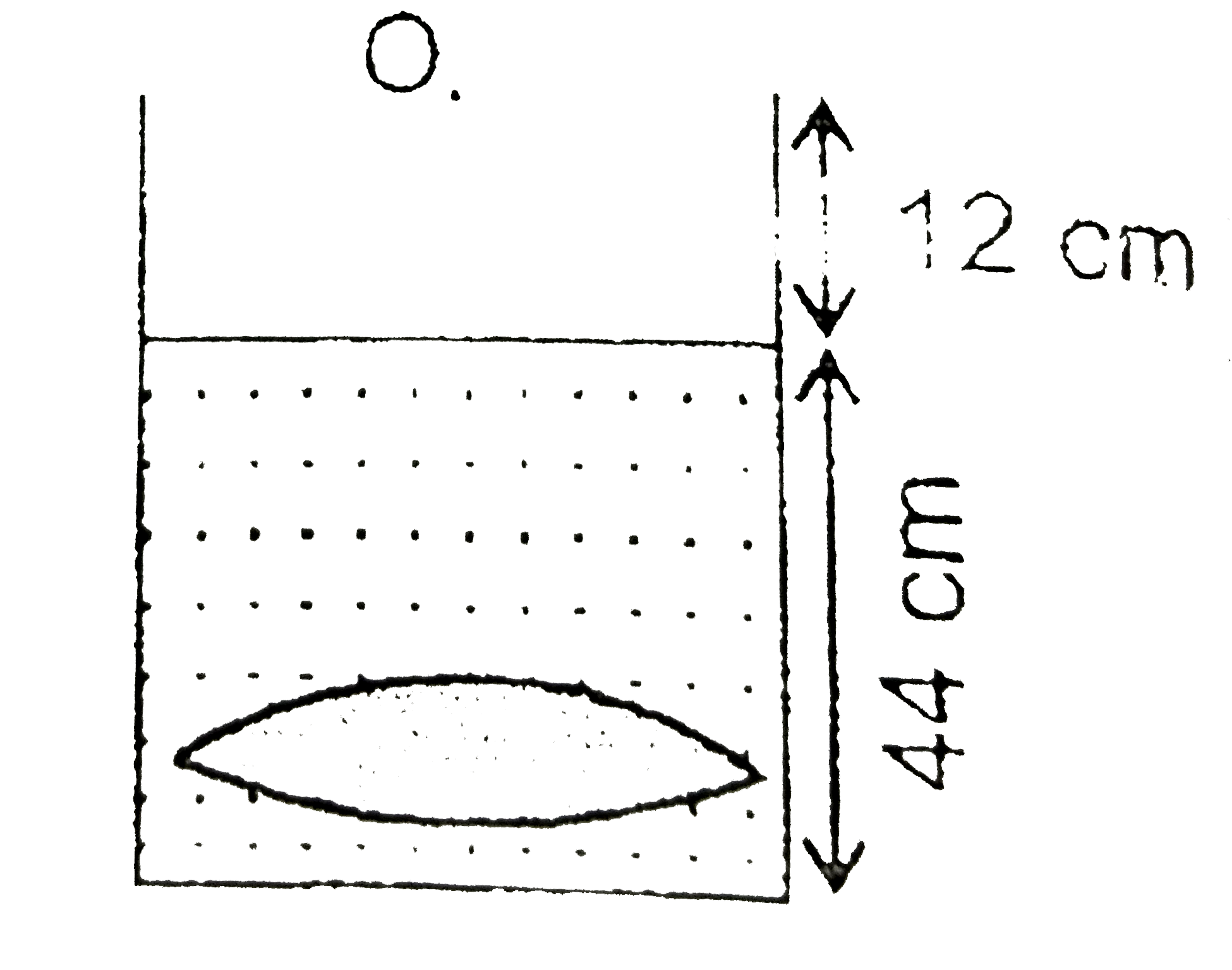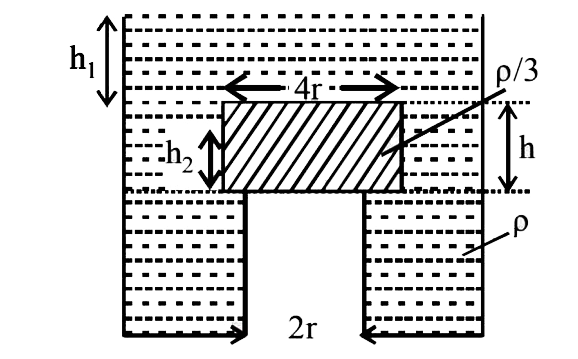A tank filled with a liquid to a height of 12.5 cm. The apparent depth of a needle lying at the bottom of the tank is measured by a microscope to be 10 cm. If water is replaced by water of refractive index 1.66 up to the same height, by what distance (in mm) would the microscope have to be moved to focus on the needle again?
To solve the problem, we need to find out how much the microscope needs to be moved to focus on the needle again after the liquid in the tank is replaced with another liquid of a different refractive index.
1. Identify Given Values:
- Height of the liquid in the tank, h=12.5 cm
- Apparent depth of the needle in the first liquid, happarent1=10 cm
- Refractive index of the new liquid, μ=1.66
2. Calculate the Apparent Depth in the New Liquid:
The formula for apparent depth is given by:
happarent=hμ
Substituting the known values:
happarent2=12.5cm1.66
Performing the calculation:
happarent2≈7.56cm
3. Determine the Shift Required for the Microscope:
The microscope was initially focused at an apparent depth of 10 cm. Now, it needs to be adjusted to focus at the new apparent depth of approximately 7.56 cm. The shift required is:
Shift=happarent1−happarent2
Substituting the values:
Shift=10cm−7.56cm=2.44cm
4. Convert the Shift to Millimeters:
Since the answer needs to be in millimeters, we convert centimeters to millimeters:
Shift in mm=2.44cm×10=24.4mm
5. Final Answer:
The microscope needs to be moved approximately 24.4 mm to focus on the needle again.
- Height of the liquid in the tank, h=12.5 cm
- Apparent depth of the needle in the first liquid, happarent1=10 cm
- Refractive index of the new liquid, μ=1.66
The formula for apparent depth is given by:
happarent=hμ
Substituting the known values:
happarent2=12.5cm1.66
Performing the calculation:
happarent2≈7.56cm
The microscope was initially focused at an apparent depth of 10 cm. Now, it needs to be adjusted to focus at the new apparent depth of approximately 7.56 cm. The shift required is:
Shift=happarent1−happarent2
Substituting the values:
Shift=10cm−7.56cm=2.44cm
Since the answer needs to be in millimeters, we convert centimeters to millimeters:
Shift in mm=2.44cm×10=24.4mm
The microscope needs to be moved approximately 24.4 mm to focus on the needle again.
Topper's Solved these Questions
- RAY OPTICS Book:VMC MODULES ENGLISHChapter:RAY OPTICS Exercise:Example
Explore 21 Videos
- RAY OPTICS Book:VMC MODULES ENGLISHChapter:RAY OPTICS Exercise:PRACTICE EXERCISE-1
Explore 1 Video
- QUIZBook:VMC MODULES ENGLISHChapter:QUIZExercise:PHYSICS
Explore 30 Videos
- RAY OPTICS AND WAVE OPTICS Book:VMC MODULES ENGLISHChapter:RAY OPTICS AND WAVE OPTICS Exercise:IMPECCABLE
Explore 58 Videos
Similar Questions
An object P is focussed by a microscope M. A glass slab of thickness 2'1 cm is introduced between P and M. If the refractive index of the slab is P5, by what distance should the microscope be shifted to focus the object again ?
View SolutionA microscope is focused on a mark on a piece of paper and then a slab of glass of thickness 3cm and refractive index 1.5 is placed over the mark. How should the microscope be moved to get the mark in focus again ?
View Solution
Knowledge Check
A tank is filled with water to a height of 15.5cm. The apparent depth of a needle lying at the bottom of the tank is measureed by a microscope to be 8.5cm. If water is replaced by a liquid of refractive index 1.94 upto the same height by what distance would the microscope have to be moved to focus on the needle again ?
A1.00cmB2.37cmC0.51cmD3.93cmThe apparent depth of a needle laying at the bottom of the tank, which is filled with water of refractive index 1.33 to a height of 12.5 cm is measured by a microscope to be 9.4cm. If water is replaced by a liquid of refractive index 1.63 upto the same height. What distance would the microscope have to be moved to focus on the needle again ?
A1.73cmB2.13cmC1.5cmD2.9cmA microscope is focused on a mark on a piece of paper and then a slab of glass of thickness 3cm and refractive index 1.5 is placed over the mark. How should the microscope be moved to get the mark in focus again ?
A4.5cm downwardB1cm downwardC2cm downwardD1cm upward
An object O is kept in air and a lens of focal length 10cm (in air) is kept at the botton of a container which is filled upto a height 44cm by water. The refractive index of water is 4/3 and that of glass is 3/2. The botton of the container is closed by a thin glass slab of refractive index 3/2. Find the distance (in cm) of the final image formed by the system from botton of container (refer to figure shown below).

View SolutionA microscope is focussed on a coin lying at the bottom of a beaker. The microscope is now raised up by 1cm. To what depth should the water be poured into the beaker so that coin is again in focus ? (Refration index of water is 4/3)
View SolutionA travelling microscope is focussed on to a scratch on the bottom of a beaker. Water of refractive index 43 is poured in it. Then the microscope is to be lifted through 2 cm focus it again. Find the depth of water in the beaker.
View SolutionAssertion A diverging lens (in air) cannot be made more diverging whatever be the medium we choose completely immerse the lens.
Reason The minimum refractive index of any medium is 1.
View SolutionA cylindrical tank has a hole of diameter 2r in its bottom. The hole is covered wooden cylindrical block of diameter 4r, height h and density ρ/3.

Situation I: Initially, the tank is filled with water of density ρ to a height such that the height of water above the top of the block is h1 (measured from the top of the block).
Situation II: The water is removed from the tank to a height h2 (measured from the bottom of the block), as shown in the figure. The height h2 is smaller than h (height of the block) and thus the block is exposed to the atmosphere.
Find the minimum value of height h1 (in situation 1), for which the block just starts to move up?
View Solution